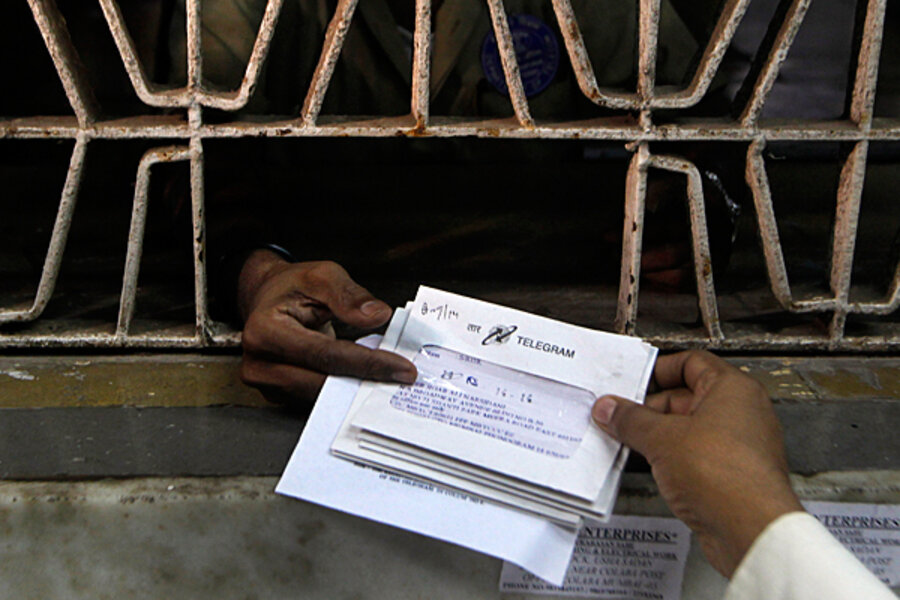India to end state-run telegram service. Stop.
Loading...
| New Delhi
(Editor's Note: The original story incorrectly heralded the worldwide demise of the telegram. In fact, some telegram services live on, including an international telegram service that will continue to operate in India even as the state-run service is shutting down.)
At the Bharat Sanchar Nigam Limited (BSNL), India's state-owned telecom company, a message emerges from a dot matrix printer addressing a soldier's Army unit in Delhi. "GRANDMOTHER SERIOUS. 15 DAYS LEAVE EXTENSION," it reads. It's one of about 5,000 such missives still being sent every day by telegram – a format favored for its "sense of urgency and authenticity," explains a BSNL official.
But the days of such communication are numbered: BSNL will send its last telegram message somewhere in India on July 14.
That missive will come 144 years after Samuel Morse sent the first telegram in Washington, and seven years after Western Union shuttered its services in the United States. In India, telegraph services were introduced by William O'Shaughnessy, a British doctor and inventor who used a different code for the first time in 1850 to send a message.
The BSNL board, after dilly-dallying for two years, decided to shut down the service as it was no longer commercially viable.
"We were incurring losses of over $23 million a year because SMS and smartphones have rendered this service redundant," Shamim Akhtar, general manager of BSNL's telegraph services, told the Monitor.
An important tool of British colonial administration and control in India, the telegram is connected with some key moments in Indian history, such as helping the British put down a popular revolt in 1857 and being the mode of communication with which Indian Prime Minister Jawaharlal Nehru informed London of Pakistan's invasion of Kashmir.
Colloquially known as "taar" or wire in India, the telegram has been a part of Indian life, a metaphor for an urgent message, bypassing the delays of the postal system. Responsible for a twist in the plot of many a Bollywood film, telegrams were often the harbinger of the news of the death of a family member. Today, death telegrams, still priced at a fifth of the regular fee, account for less than 1 percent of telegram traffic.
At their peak in 1985, 60 million telegrams were being sent and received a year in India from 45,000 offices. Today, only 75 offices exist, though they are located in each of India's 671 districts through franchises. And an industry that once employed 12,500 people, today has only 998 workers.
One of them is R.D. Ram, who has been working in the Delhi office for 38 years. "They will now move me to another department where I will feel like a fresher [beginner]," he complains.
Mr. Ram once learned the Morse code technology for telegraphy, but today oversees staff who type out and send telegrams over a Web software. He tries to put up a spirited defense of the obsolete technology in the age of the smartphone, arguing that mobile penetration is much lower than it is hyped to be. Mobile penetration is indeed a dismal 26 percent, but even in the remotest village, at least someone has a phone.
Ram notes that the telegram has legal benefits as well. "It is still accepted by the courts as a valid form of evidence. And is taken seriously by a judge when a government official sends a telegram to say he is unwell and cannot be present in court today," he says.
Sixty-five percent of daily telegrams are sent by the government. But it is the remaining 35 percent that Ram worries about. A number of telegrams are from runaway couples who marry secretly because their parents wouldn't let them marry in the wrong caste, class, or religion. "They inform their parents that they are married, and fearing violence from the family, inform the police and the National Human Rights Commission," he said.
Saddened as Ram is by the impending death of his profession, his sentiment could not match that of a telegraph whose sender threatened suicide unless the decision was overturned. The telegram was from A.P. Tripathi, who runs an anticorruption nonprofit in Lucknow. Addressed to the president, prime minister, the minister for communications, and others, it said that he would engage in a Gandhian fast unto death if telegram services were shut down, and if he died, then the addressed officials would be responsible.
When contacted, Mr. Tripathi claimed he had not threatened suicide, only a Gandhian fast. "I am a regular user of the telegram and it is an important tool for activists," he explains. "For example, a telegram to a court informing them of illegal detention of a citizen by the police is taken as a writ petition."
In Delhi, the telegraph office has not passed on his telegram yet, marking it as "objectionable."








